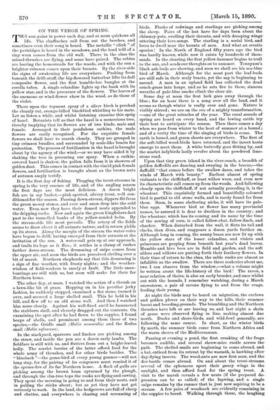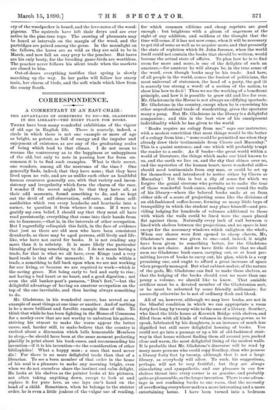ON THE VERGE OF SPRING.
TH B sun gains in power each day, and at noon quickens all life. The chaffinches call from out the beeches, and sometimes even their song is heard. The metallic " clink " of the partridges is heard in the meadows, and the loud trill of a tiny wren comes from the old wall. There in the elms the missel-thrushes are flying, and some have paired. The robins are leaving the homesteads for the woods, and with the sun a brighter crimson comes upon their breasts. By the river-side the signs of awakening life are everywhere. Pushing from beneath the drift-stuff, the big-flowered butterbur lifts its dull composite flower, and the first humble-bee bungles at the corolla tubes. A single celandine lights up the bank with its yellow star, and is the precursor of the flowers. The leaves of the anemone or wind-flower show in the wood, as do those of the violet.
There upon the topmost spray of a silver birch is perched the cleanly cut, orange-billed blackbird whistling to his mate. Let us listen a while, and whilst listening examine this sprig of hazel. Botanists tell us that the hazel is a moncecious tree, thereby implying that its flowers are of two kinds, male and female. Arranged in their pendulous catkins, the male flowers are easily recognised. For the exquisite female flowers we shall have to search closely. They are grouped in tiny crimson bundles, and surrounded by scale-like bracts for protection. The process of fertilisation in the hazel is brought about•by the agency of the wind,—or we may have aided it by shaking the tree in procuring our spray. When a catkin- covered hazel is shaken, the pollen falls from it in showers of golden dust. This comes in contact with the viscid pink female flowers, and fertilisation is brought about as the brown nuts of autumn amply testify.
It is the first day of fishing. Flogging the trout-streams in spring is the very essence of life, and of the angling season the first days are the most delicious. A dozen bright fish are in my basket,—pink-spotted, silvery trout, well con- ditioned for the season. Passing down-stream, dippers flit from the green mossy stones, and ever and anon drop into the cold water. Even now they have their domed nests appended to the dripping rocks. Now and again the green kingfishers dart past to the tunnelled banks of the yellow-sanded holm. By the stream-side life most prevails. The artery of the fields seems to draw about it all animate nature, and in return yields up its stores. Along the margin of the stream the water-voles have begun to drill, having emerged from their retreats at the invitation of the sun. A water-rail gets up at our approach, and trails its legs as it flies ; it settles in a clump of rushes farther down-stream. The drumming of snipe comes from the upper air, and soon the birds are perceived circling over a bit of marsh. Northern shepherds say that this drumming is a sign of fine weather, with frosty nights ; and the weather- wisdom of field-workers is rarely at fault. The little snow- buntings are still with us, but soon will make for their far Northern home.
The other day, at noon, I watched the action of a thrush on a lawn-like bit of grass. Hopping on in his peculiar jerky fashion, he suddenly stopped, examined a flat stone, turned it over, and secured a large shelled snail. This he held in his bill, and flew off to an old stone wall. And then I watched him more closely. Against his well-fixed anvil he hammered the stubborn shell, and cleverly dragged out the contents. On examining the spot after he had flown to the coppice, I found heaps of shells, and prominent among them those of two species,—the Gridle snail (Helix neinoralis) and the Rufus snail (Helix refuscens).
In the stackyard, sparrows and finches are picking among the straw, and inside the pen are a dozen early lambs. The fieldfare is still with us, and flutters from out a blight-leaved holly. The scarlet berries of the latter afford food for the whole army of thrushes, and for other birds besides. The " blueback "—the game-bird of every young gunner—will not long stay, for the pairing of its congeners must remind it of the spruce-firs of its far Northern home. A flock of gulls are picking among the brown loam upturned by the plough, and through the elm-tree tops the rooks are flying and cawing. They spent the morning in going to and from their nests, and in pulling the sticks about; but as yet they have not got seriously to work. In the land, the hedgerows are full of cheep and chatter, and everywhere is chasing and screaming of birds. Flocks of redwings and starlings are picking among the sheep. Pairs of the last have for days been about the chimney-pots, swelling their throats, and with drooping wings uttering their love-songs. The starling is a social bird, and loves to dwell near the haunts of men. And what an erratic species ! In the North of England fifty years ago the bird was hardly known, while now it exists by hundreds of thou- sands. In the clearing, the first yellow-hammer begins to troll to the sun, and sends our thoughts on to summer. Tennyson's black ash-buds are showing, and soon we shall see his sea-blue bird of March. Although for the most part the leaf-buds are still safe in their scaly bracts, yet the sap is beginning to ascend. A man in an upland 'field has collected the dead couch-grass into heaps, and as he sets fire to these, sinuous wreaths of pale-blue smoke climb the clear air.
Some day at noon the first lark goes away through the blue ; for an hour there is a song over all the land, and it seems as though winter is really over and gone. Nature is visibly stirred; we are on the eve of a mighty transformation, —one of the great miracles of the year. The rural sounds of spring are heard on every hand, and the lowing cattle try their best to anticipate the season. Then there comes a day when we pass from winter to the heat of summer at a bound ; and of a verity the time of the singing of birds is come. The earth is loosed, and green shoots are everywhere. The first of the soft-billed wood-birds have returned, and the insect hosts emerge to meet them. A white butterfly goes flitting by, and the scarlet ladybirds lazily revolve about the powdered lime- stone road.
Upon that tiny green island in the river-reach, a breadth of golden daffodils are dancing and swaying in the breeze,—the daffodil " that comes before the swallow dares, and takes the winds of March with beauty." Earliest almost of spring visitants is the chiffchaff, or least willow wren, and even now its characteristic call comes up from the woods. And following closely upon the chiffchaff, if not actually preceding it, is the wheatear. This exquisitely formed and beautifully coloured bird is partial to old stone walls, and is rarely found far from them. Soon, in some sheltering niche, it will have its pale- blue eggs. Whenever bird or flower has many provincial names, be assured it is dear to dwellers in the country; and the wheatear, which has its coming and its name by the time of the sowing of corn, is called fallow-chat, fallow-finch, and checker. When disturbed from the wall, it flirts its tail and clacks, then dives, and reappears a dozen yards further on- Although long in coming, the sunny braes are now lit up with the yellow stars of the lesser celandine, and violets and primroses are peeping from beneath last year's dead leaves._ Humble and hive bees are in field and garden, and the soft alders and willows are putting forth their feathery flowers. In their time of return to the elms, the sable rooks are almost as infallible as the swallow. There are three rookeries about me, two I can observe from the window,—what a volume might be written anent the life-history of the bird ! The raven, a, near relation of theirs, is also an early breeder, and once whilst out with the hounds, I remember watching, during a March snowstorm, a pair of ravens flying to and from the crags, feeding their young.
At night the birds may be heard on migration, the curlews and golden plover on their way to the hills, their summer haunt and breeding grounds. The brambling and the Northern thrushes have left or are leaving us, and last night a skein of geese were observed flying in line, making almost due north. Ducks and shore-birds, and wild-fowl generally, are following the same course. In short, as the winter birds fly north, the summer birds come from Northern Africa and the warm shores of the Mediterranean.
Passing at evening a pond, the first croaking of the frogs becomes audible, and several shrew-mice rustle across the path. The shelled snails are beginning to come abroad, and a bat, enticed from its retreat by the warmth, is hawking after day-flying insects. The wood-ants are now first seen, and the dor-beetle comes abroad. On and about the trout-streams• several of the ephemerm sport their gauzy wings in the sunlight, and then afford food for the spring trout. A visit to the marsh reveals a few nests (if the prepared de- pression can be so called) of the lapwing, and a single snipe remains by the runner that ift-just now aspiring to be a stream. A few pairs of woodcock are evidently remaining in the coppice to breed. Walking through these, the laughing
cry of the woodpecker is heard, and the love-notes of the wood- pigeons. The squirrels have left their dreys and are ever active in the pine-tree tops. The crowing of pheasants may be heard at intervals on the margin of the wood, and the partridges are paired among the gorse. In the moonlight on the fallows, the hares are as wild as they are said to be in March, and now fall an easy prey to the poacher. But hares are his only booty, for the breeding game-birds are worthless. The poacher never follows his silent trade when the markets are closed to him.
Out-of-doors everything testifies that spring is slowly marching up the way. In her paths will follow her starry train, her charm of birds, and the soft winds which blow from the sunny South.







































 Previous page
Previous page